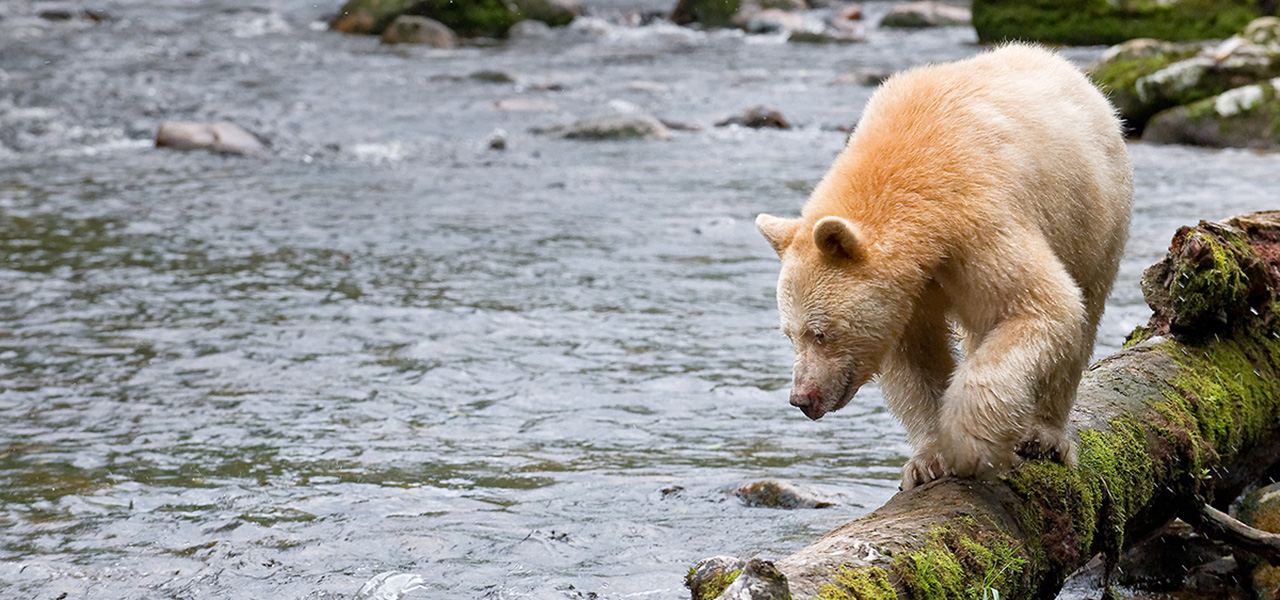A great origin story is always rooted in an extraordinary place, and the story of MakeWay is no exception. MakeWay’s birthplace is one of the most unique and spectacular places on Earth—the globally significant and biologically rich Great Bear Rainforest.
Located on the central and north coast of British Columbia, the Great Bear Rainforest is vast—over twice the size of Vancouver Island—and home to 26 First Nations. It contains one of the world’s largest intact coastal temperate rainforests, varied freshwater and inshore marine systems, and a magnificent array of wildlife, including salmon, grizzly bears, and the rare white Spirit Bear, which exists only in this part of the world. The adjacent Great Bear Sea is a diverse and productive marine environment.
From this uncommon place was born an uncommon way of dealing with tough problems, a way of operating that has become “a fundamental part of Tides Canada’s [now MakeWay’s] DNA,” says former President and CEO Ross McMillan, who has been with Tides Canada/MakeWay from our initial days. “The approach that Tides Canada adopted in our early work in the Great Bear Rainforest is key to how we still operate today. We don’t shy away from thorny, intractable problems that are going to take years, and involve multiple parties working together, to solve. We’ve learned much about collaboration, perseverance, and creativity from all of our partners in the Great Bear Rainforest—lessons that help us shape our work across the country in fundamental ways.” It’s an approach that involves considerable time, expertise, sensitivity, and effort, but the results can be extraordinary.
The War in the Woods
In the late 1990s, the Great Bear Rainforest was under threat from aggressive plans to log the entire ecosystem, a new front in “The War in the Woods” in British Columbia. The Clayoquot Sound protests had just concluded to the south on Vancouver Island, and the Great Bear Rainforest (then called the “North and Mid-Coast Timber Supply Areas” by government and industry) was the next region in the sights of the timber companies.
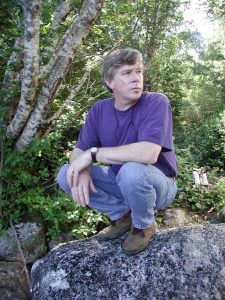
Ross knew the area well, having started his working life there as an 18-year-old logger. He also fished along the region’s coastline as a youth, often on his family’s commercial fishing boat. “I have lived and worked in small coastal communities for a significant part of my life. My kids were born in Tofino, on the west coast of Vancouver Island. I have always felt deeply connected to the BC coast and the people who live there,” he says.
By the mid-1990s, Ross became involved in helping to find solutions to ongoing conflicts in Clayoquot Sound. It was a time when he was honing his ability to bring different—often opposing—groups together. He had been working for the Government of BC to help build positive relationships with First Nations, when, in 1994, he was appointed co-chair of a new management board in Clayoquot Sound. It was the province’s first resource management body where decision-making was shared between First Nations and government. It was a life-changing experience for Ross. He worked in active partnership with First Nations leaders and elders and non-Indigenous community leaders, to help bridge cultural divides and incorporate Indigenous perspectives into resource management decisions.
After chairing the board, Ross continued to work alongside the Nuu-chah-nulth First Nations, local communities, and the provincial and federal governments for several years to have Clayoquot Sound designated a UNESCO biosphere reserve, a status awarded to the region in 2000. He also oversaw the design process and community consultations that led to the establishment of the Clayoquot Biosphere Trust, an endowed charitable foundation created that year to support research and education in the Clayoquot Sound biosphere region.
Meanwhile, controversy and tensions were mounting over plans to ramp up logging in the Great Bear Rainforest. First Nations were concerned about the environmental impacts of destructive logging practices and the lack of economic benefits for their communities from ongoing logging, with some First Nations blockading logging activities in their territories. Environmental organizations were running effective public campaigns in Europe, the United States, and Asia to target BC forest product customers, urging them to boycott products from the province’s logging companies and calling for more protection of important habitat in the area. Industry was feeling the pressure from all sides.
Fostering consensus about the fate of the region among these different players would be necessary for success and also the hardest thing to achieve. Another challenge was the sheer enormity of the region—there was a lot of territory under consideration, far more than in Clayoquot Sound. As well, Ross notes that there was “a growing recognition that First Nations had to be a fundamental part of any solution rather than an afterthought, but not all parties understood Indigenous rights and interests and how to respectfully engage with First Nations.”
From these challenges—and the tenacity and collaborative spirit required to address them—MakeWay’s unique approach was forged.
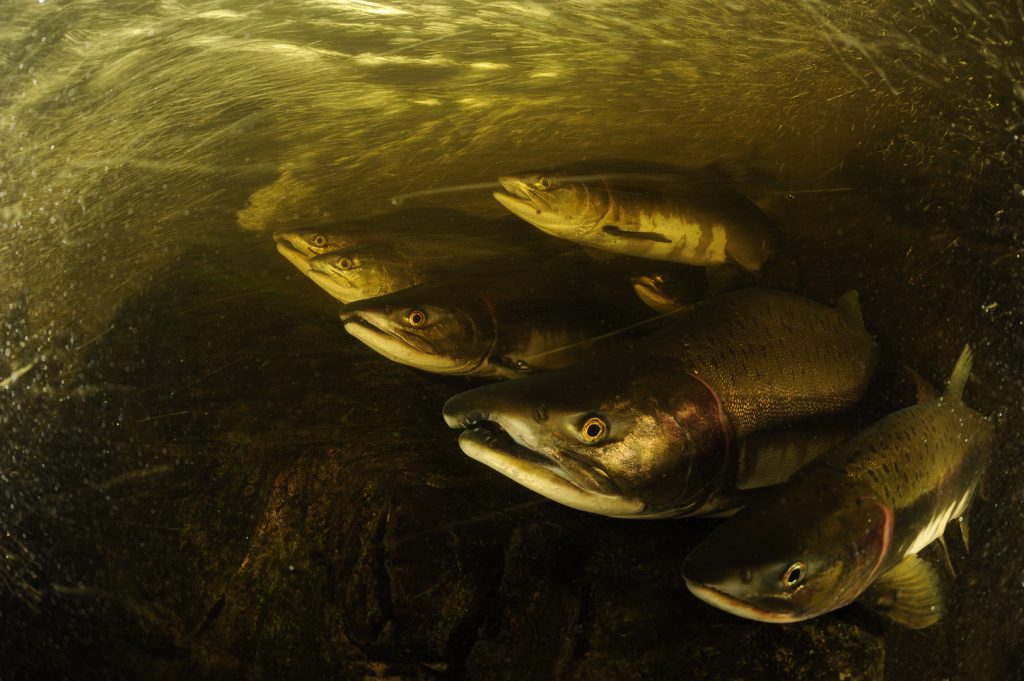
Born into a new millennium
Tides Canada (now MakeWay) was officially founded in 2000 by a group of philanthropists with financial support from the Endswell Foundation. That same year, our first shared platform project—the Rainforest Solutions Project—was launched. The project was initiated in partnership with a group of environmental organizations, including the Sierra Club of BC, Greenpeace Canada, and ForestEthics Canada. Ross was recruited as the Rainforest Solutions Project’s first director, and he soon began to advise MakeWay on its broader work in the region.
Meanwhile, the environmental organizations participating in the multi-party land use planning processes established in the area by the BC government had brokered a truce with logging companies, which helped reduce tensions and provided space for creativity in the negotiations over the region’s future. In return for the companies agreeing to not proceed with logging in any intact valleys in the Great Bear Rainforest, environmental groups agreed to suspend their international campaigns.
But it wasn’t just environmental groups and forest companies that had to reverse their earlier approaches. The BC government agreed to drop prior conditions in the land use planning processes too, including arbitrary limits on the amount of the region that could be protected. And First Nations decided to open a new dialogue with the Crown and other parties apart from treaty negotiations to assert their rights and interests. These were remarkable first steps from all parties.
With the truce in place, the Rainforest Solutions Project began developing proposals for conservation area design and an innovative new approach to manage resources in the region, called ecosystem-based management, which all of the parties would continue to refine through years of negotiation. The goal of this approach was to ensure that logging and other resource extraction activity would not compromise the health and well being of ecosystems and communities.
As negotiations in the multi-party land use planning process continued to unfold, MakeWay’s work expanded, and the integrated approach we are now known for began to be formed. In addition to housing the work of the Rainforest Solutions Project on our shared platform, MakeWay pursued a variety of initiatives, often in collaboration with other parties. We supported First Nations in the Great Bear Rainforest so they could convene, share information, develop common strategies and negotiating positions, and conduct specific studies and mapping within their respective territories. We collaborated with environmental organizations, government, industry, and academic institutions to design and fund studies on everything from biodiversity values to economic activity, which supported all participants in the land use planning negotiations. And in 2002, Ross began to coordinate the work of a group of international foundations to help build a plan for conservation financing in Great Bear Rainforest. The foundations, coastal First Nations, and the BC government jointly established the Conservation Investments and Incentives Initiative, an unprecedented collaboration charged with building a plan to attract investment in the region to support ambitious conservation goals.
The conservation financing work was a critical condition for success in the Great Bear Rainforest. All parties realized that significant resources would be needed to provide participating First Nations with revenue to fund conservation management initiatives and to transition the region away from reliance on unsustainable resource extraction. Ross led negotiations on behalf of the foundation collaborative to shape the financing package, develop legislative changes to recognize Aboriginal rights and interests, as well as biodiversity values, in new protected area designations, and the design and establishment of new institutions to oversee public and private funding in the region. MakeWay took responsibility for raising funds in Canada, while The Nature Conservancy led fundraising efforts in the United States. Environmental groups and First Nations leaders also played key roles in the fundraising effort.
We approached Canadian funders from all walks of life to stimulate their interest in what was unfolding in the Great Bear Rainforest. This was at a time when many people still thought that the conflict in the region was just too entrenched to ever be solved. “We had to convince sophisticated funders that there was a significant chance of success and that the emerging conservation and economic plans were rooted in reality,” says Ross. “We had to demonstrate the scientific strength of the case for biodiversity protection. We also had to bring in other voices that reinforced our perspective about the balance of ecological and human considerations, including First Nations partners and, in some cases, company and government officials, before large-scale investments were made.”
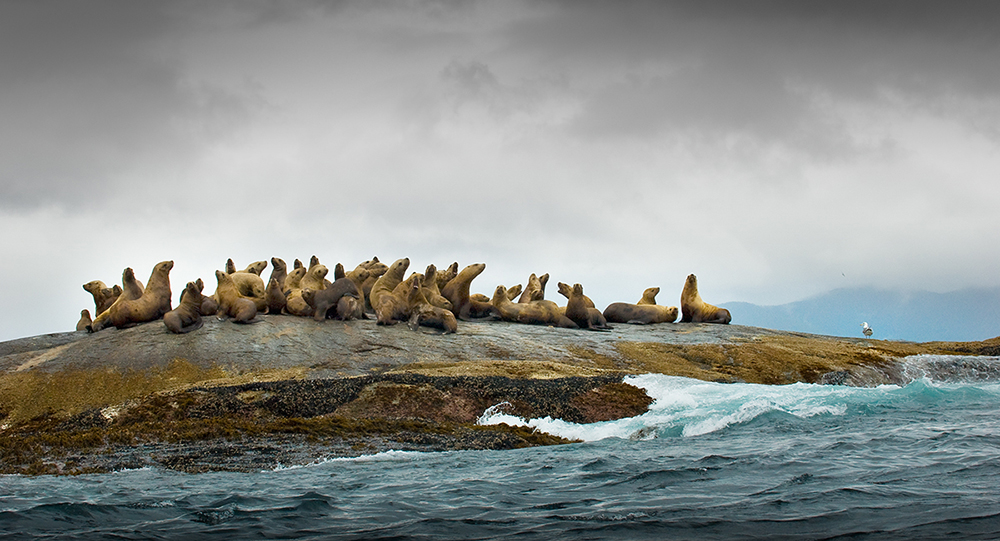
Unprecedented agreements
In 2006, a huge milestone was reached—the parties in the land use planning negotiations announced agreements that created a network of 194 protected areas totalling 2.6 million hectares, along with an initial framework for ecosystem-based management in the region (which would be further developed over the next decade). The BC government and First Nations also negotiated protocols for how they would collaborate on future land and resource management decision-making.
Meanwhile, the conservation financing effort advanced rapidly. In early 2007, MakeWay and our partner foundations, First Nations, the Rainforest Solutions Project partners, and the federal and provincial governments announced we had secured an unprecedented $120 million to support the approved conservation plans. We also announced the establishment of two new organizations, known collectively as the Coast Funds, to oversee private and public investments in the region. The Coast Funds included a conservation fund dedicated to First Nations’ conservation management initiatives and an economic development fund to foster sustainable business and job creation in First Nation communities.
Following the launch of the Coast Funds that year, Ross was appointed as Tides Canada’s president.
Global impacts, and a foundational approach
In the decade that has followed, we have continued our work in the region, largely through funding vital work conducted by First Nations communities and NGOs to build capacity for stewardship, to support marine planning initiatives in the Great Bear Sea, to end trophy hunting, to protect wild salmon, and much more. We have also continued to support the Rainforest Solutions Project partners and their vital contributions in shaping the final management framework for the region.
In 2016, after almost two decades of hard work and negotiations, First Nations, the Province of British Columbia, logging companies, and environmental organizations finalized the ecosystem-based management framework to conclude what is now the most significant integrated forest management plan in North America. Together, the parties increased formal protected areas to 44% of the forest land base and protected an additional 41% through reserves and other mechanisms. This resulted in protection for 85% of Great Bear Rainforest’s old-growth forests. It also built a foundation for sustainable economies to promote human well being and ecological heath in the area.
That same year, after seven years of challenging multi-party marine planning negotiations, coastal First Nations and the BC government reached another landmark agreement on comprehensive marine plans in the off shore Great Bear Sea. MakeWay provided the administrative home for this unique collaboration from its earliest days, and we continue to support the work of the parties to implement the agreement.
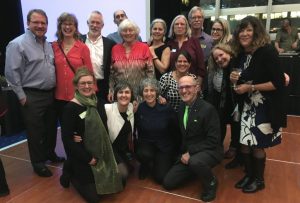
“I feel fiercely proud of the role that MakeWay played—and continues to play—to support the organizations and people in the region who are so passionate about responsible stewardship and cultural continuity,” says Ross. “I’m particularly proud of the work that we have done in partnership with First Nation communities. First Nations asserted their rights and title and regained an immense say over the management of their territories in the land and marine use processes over the past 20 years. They are building a new economy rooted in human health and stewardship rather than exploitation, and that has had, and will continue to have, tremendously positive impacts that benefit us all.”
The Great Bear Rainforest terrestrial agreements comprise one of the most historically significant and comprehensive multi-party conservation deals ever negotiated, and they offer a leading example of environmental conflict resolution that respects and supports Indigenous rights. Already they have been used as a model for similar negotiations in Canada’s boreal forest and the rainforests of Chile.
The Coast Funds to date have deployed more than $240 million in the Great Bear Rainforest, supporting work in multiple economic sectors and dozens of protected areas. More than 750 permanent new jobs have been created, representing 10% of the First Nations workforce in the region.
In 2016, the Rainforest Solutions Project received the Buckminster Fuller Challenge Prize, in recognition of its work to push the boundaries of socially responsible design in support of the Great Bear Rainforest agreements.
And the early-stage marine plans in the Great Bear Sea announced in 2016 have the potential to be shaped into world-leading examples of collaborative marine spatial planning and oceans stewardship.
“Our contributions to success in the Great Bear Rainforest and Sea, and the lessons we have learned along the way, have shaped MakeWay in fundamental ways, and they have helped us grow into a national leader in integrated philanthropic solutions,” says Ross. “Today we are applying the same approaches and tools in other geographies and on other issues across the country, adapting our approach to suit local circumstances.”
It’s an approach that’s now as much a part of MakeWay as of the Great Bear Rainforest itself.
